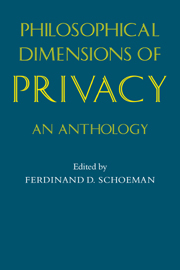Book contents
- Frontmatter
- Contents
- List of contributors
- Preface
- 1 Privacy: philosophical dimensions of the literature
- 2 Social distance and the veil
- 3 The origins of modern claims to privacy
- 4 The right to privacy [the implicit made explicit]
- 5 Privacy [a legal analysis]
- 6 Privacy as an aspect of human dignity: an answer to Dean Prosser
- 7 Privacy [a moral analysis]
- 8 Privacy, freedom, and respect for persons
- 9 Privacy and self-incrimination
- 10 Intimacy and privacy
- 11 The right to privacy
- 12 Why privacy is important
- 13 Privacy, intimacy, and personhood
- 14 Privacy: some arguments and assumptions
- 15 An economic theory of privacy
- 16 Privacy and the limits of law
- 17 Privacy and intimate information
- Selected bibliography
- Index of names
11 - The right to privacy
Published online by Cambridge University Press: 12 December 2009
- Frontmatter
- Contents
- List of contributors
- Preface
- 1 Privacy: philosophical dimensions of the literature
- 2 Social distance and the veil
- 3 The origins of modern claims to privacy
- 4 The right to privacy [the implicit made explicit]
- 5 Privacy [a legal analysis]
- 6 Privacy as an aspect of human dignity: an answer to Dean Prosser
- 7 Privacy [a moral analysis]
- 8 Privacy, freedom, and respect for persons
- 9 Privacy and self-incrimination
- 10 Intimacy and privacy
- 11 The right to privacy
- 12 Why privacy is important
- 13 Privacy, intimacy, and personhood
- 14 Privacy: some arguments and assumptions
- 15 An economic theory of privacy
- 16 Privacy and the limits of law
- 17 Privacy and intimate information
- Selected bibliography
- Index of names
Summary
Perhaps the most striking thing about the right to privacy is that nobody seems to have any very clear idea what it is. Consider, for example, the familiar proposal that the right to privacy is the right “to be let alone.” On the one hand, this doesn't seem to take in enough. The police might say, “We grant we used a special X-ray device on Smith, so as to be able to watch him through the walls of his house; we grant we trained an amplifying device on him so as to be able to hear everything he said; but we let him strictly alone: we didn't touch him, we didn't even go near him—our devices operate at a distance.” Anyone who believes there is a right to privacy would presumably believe that it has been violated in Smith's case; yet he would be hard put to explain precisely how, if the right to privacy is the right to be let alone. And on the other hand, this account of the right to privacy lets in far too much. If I hit Jones on the head with a brick I have not let him alone. Yet, while hitting Jones on the head with a brick is surely violating some right of Jones', doing it should surely not turn out to violate his right to privacy. Else, where is this to end?
- Type
- Chapter
- Information
- Philosophical Dimensions of PrivacyAn Anthology, pp. 272 - 289Publisher: Cambridge University PressPrint publication year: 1984
- 18
- Cited by



